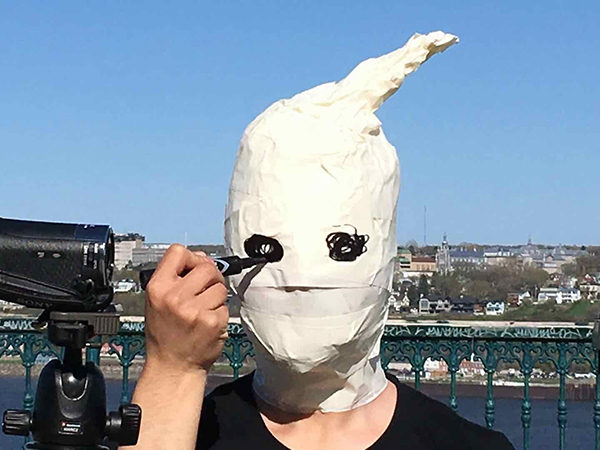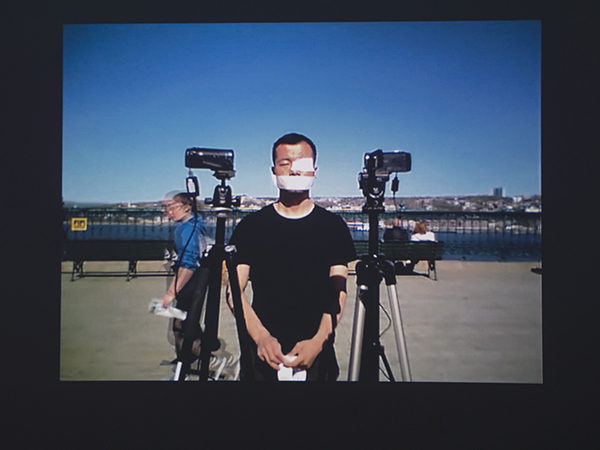Last spring, Le Lieu, centre en art actuel, and the Xiang Xishi Center For Contemporary Art organized an exchange between artists from Quebec City and the Chinese city of Xi’An. The collaboration kicked off at Le Lieu with an evening performance featuring artists Li Xiaomu and Xiang Xishi, which was followed by a conference discussing contemporary art and performance art in China. The event allowed those attending to discover an intimate practice demonstrated through simple actions, almost imperceptible, so anchored were they in day-to-day iconography. It is a political practice, almost like a protest, but with a disarming gentleness.

crédit photo: Quan Wu
One week after this evening at Le Lieu, spectators were invited to take part in an ambulatory vernissage featuring other exhibitions that were part of this exchange: the audio artwork of Wu Quan at Avatar, the photographs of Chen Hua and Su Chen at VU, and the in-situ installation of Pan Wang at LA CHAMBRE BLANCHE. Although very different from one another, these exhibitions shed light on artistic practices that were both rooted in Chinese culture and open to the rest of the world.
China is known for its economy, cuisine, and architecture, but its contemporary art scene remains generally overlooked. The fact remains that the country is still in the grip of an authoritarian regime that leaves little space for the freedom of expression. And yet, since the 1980s—a period during which China opened its markets to the West—visual art has been radically transformed in many ways, taking on a more dissenting air.

crédit photo: Quan Wu
Performance is central to this liberating means of expression, but it remains at the periphery of the official network. It is often associated with a militant art that, as much as possible, defies the limits of the law and the social norms enforced by the state. We say “as much as possible,” because the government still, to this day, exercises significant control over the population, media, and, of course, the arts. This pressure manifests through the political authorities’ frequent censorship of art1 that deviates from recognized—or, one might say, authorized—art forms. In such a context, collaborations such as the one between Le Lieu and the Xiang Xishi Center For Contemporary Art are important, even essential, for the support of non-institutional art in China, even though it may be only symbolic. This perspective undoubtedly clouded the perception of spectators viewing the artistic productions presented as part of the exchange, notably with regard to Pan Wang’s residence at LA CHAMBRE BLANCHE.
***

crédit photo: Ivan Binet
Not long after his arrival in Quebec City, Wang performed on the Dufferin terrace. Three cameras captured his performance: the first was placed directly in front of him, the second to his right, and the third to his left. As passers-by watched—some amused, some intrigued, some indifferent—the performer meticulously covered his face and head with strips of paper, constructing a mask on which he then drew two black eye sockets and a disturbing mouth. The scene where the performance was captured was then reproduced in the gallery. The three videos of the artist’s performance were projected on three of the walls. The ripped mask, suspended from the ceiling, was both an artefact of the artistic performance that had just occurred, and an avatar allowing the artist to assert his presence in the gallery. The installation was completed by a fourth projection: a close-up shot of undulating water, bathed in red.
In the spirit of the conditions of the evolution of contemporary art in China, Wang’s work inevitably sparked certain reflections. First, the performance took place in a public space, in particular a very touristic, even emblematic site in Quebec City. Through this performance and the choice of location, the artist made his presence in the city known and, at the same time, affirmed the role of art in our social fabric. Given that such artistic performances are often censored in Wang’s home country, his choice to perform in front of some of Quebec City’s most recognizable architecture is far from trivial.

crédit photo: Ivan Binet
The devices used to capture the performance also raised many points of reflection. It was obviously necessary for the artist to film the performance in order to later transform the footage into a gallery installation. Having said this, since the cameras were placed one in front of the other, they filmed not only the artist and his performance, but the other cameras as well. In other words, the cameras became a key part of the artwork, seen alongside the performer during the performance and in the video installation. Spectators were thus unsure whether they were simple cameras being used to document the performance art, or whether they acted as surveillance cameras capturing even the smallest actions of the artist. The construction of the mask also fuelled this insecurity, as Wang concealed his true identity behind a disturbing, anonymous face.
Lastly, the fourth projection of red water was simultaneously calming and upsetting. Showing a close-up shot over a relatively calm body of water, the video first appeared meditative. However, the scarlet-red colour induced a certain incongruity in the image. Why that colour? Was it a reference to the Chinese flag? Or perhaps an allusion to the famous Little Red Book?

crédit photo: Ivan Binet
All these elements together created an unsettling ambiance, as if there were a discrepancy between the spectator and what was displayed (the cameras, the mask, the red screen). However, by making visible the method of filming and diffusion, Wang also revealed the filter through which his gestures, actions, identity and his art eventually reached those watching. With full consciousness, and in a resilient and lucid manner, Wang affirmed his presence in the public space. Through his simple gestures during the performance, Wang shared a certain anxiety, but also a desire to be seen, to be heard, to be known and recognized.
- Some experts, such as author and speaker Madeleine O’Dea, even consider that the country is currently going through a period of retrenchment characterized by an increasingly frequent use of censorship. O’Dea, Madeleine. 2017, The Phoenix Years: Art, Resistance, and the Making of Modern China. New York: Pegasus Books, 360 p.